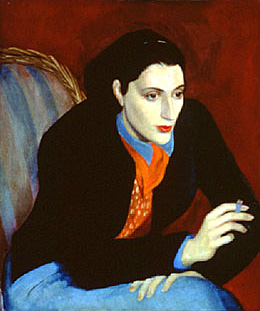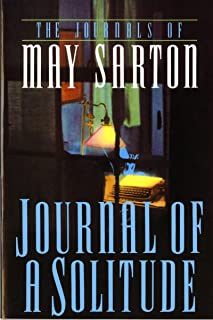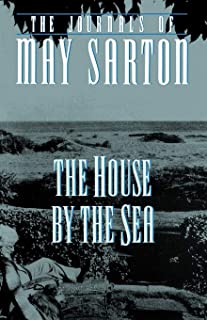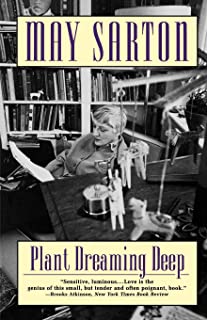- Read
- On The Writer
- On The Writing
- Favorite Quotes
- Photos
- Film and Audio
- Bibliography
- News
- Order Books
May Sarton Bio
May Sarton, US author and poet, was born on March 5, 1912 10:30 PM GMT in Ghent, BelgiumMay Sarton (1912-1995)
At her death, May Sarton had written 53 books: 19 novels, 17 books of poetry, 15 nonfiction works including her acclaimed journals, 2 children's books, a play, and some screenplays. I've tried to list first editions here, whenever possible, or at least to give the copyright date if I couldn't find a complete reference to the first edition. Many newer editions of her works are also in print. I have sometimes listed multiple editions if the illustrations or supporting materials are different. For a comprehensive bibliography describing works by and about Sarton, see May Sarton: A Bibliography. (Annotated) by Lenora P. Blouin. Metuchen, New Jersey: The Scarecrow Press, Inc., 1978.
May Sarton wished that upon her death a fund would be established from the residue of her estate to provide scholarships for poets and historians of science. (Her father was a historian of science at Harvard.) The Sarton Fund has been established and is held under the auspices of the American Academy of Arts and Sciences, of which May Sarton was a member. The Sarton Estate recorded May Sarton's memorial service, which may be ordered for a small sum that includes a donation to the fund.
To contact the Sarton Fund, write to:
Sarton Fund, c/o The American Academy of Arts & Sciences, Norton's Woods, 136 Irving St., Cambridge, MA 02138.
Source
May Eleanor Sarton, a poet and novelist, was born in Wendelgem, Belgium on May 3, 1912, and immigrated to the United States at age four. Educated in the U.S. and abroad, she has taught and lectured on poetry at a number of universities, including Bryn Mawr, Wellesley College, and Harvard. Encounter in April (1937), her first collection of lyrics, was followed by many more volumes of poetry. Her first two novels, The Single Hound (1938) and Bridge of Years (1946), had European settings, but since 1955, New England has provided the background for most of her fiction. Faithful Are the Wounds (1955) tells of a dedicated professor's suicide amid the political pressures of the McCarthy era, and Kinds of Love (1970) explores the difficulties and triumphs of human love. A Reckoning (1978) and Anger (1982) continue this exploration, but the protagonists are now middle aged and less sanguine about the possibilities in human relationships. In addition to her many novels, Sarton has written a play, a screenplay, and such personal works as The Hours by the Sea (1977) and After the Stroke: A Journal (1988).
Her sonnet sequence, A Divorce of Lovers, is a brilliant study of two lesbians and the death of their affair.
There is a film about Ms. Sarton's life entitled "World of Light: Portrait of May Sarton." Filmed with the cooperation of May Sarton herself, we get a good picture of her life as a woman writer outside the mainstream. This film documents the final period of her long career, contemplating her work, her loves, and her influence on other women. It is available for checkout at the OGLBTC (1180 BSB).
For more information:
Hunting, Constance, ed., May Sarton, Woman and Poet (1982)
Sibley, Agnes, May Sarton (1972).
Source
May Sarton, originally named Eleanor Marie Sarton, was born on May 3, 1912, in Wondelgem, Belgium. She and her family were forced to flee after the invasion by the Reichswehr in 1915, and the family settled in Boston, Massachusetts when Sarton was just four years old. For eight years she studied at the Shady Hill School in Cambridge, one of the country's first progressive schools. By the time she graduated from high school, Sarton had decided to pursue a career as an actress, and at the age of seventeen she left home to join New York's Civic Repertory Theater under Eva de Galienne. After the dissolution of the company and the failure of her own repertory theatre, the Associated Actors Theater, Sarton abandoned her dream of acting and turned her attention to writing.
In 1945, while on vacation in Sante Fe, Sarton met Judy Matlack, a professor of English at Simmons College, who became her lover and companion of thirteen years. The couple separated after the death of Sarton's father, when Sarton moved to Nelson, New Hampshire. She later relocated to York, Maine, where she spent the last twenty years of her life.
During the early part of her career, Sarton enjoyed a good deal of critical acclaim, but later reviews were often harsh and even vicious. Sarton suffered from bouts of depression and self-doubt throughout her life, during which she questioned her talent and, on one occasion, almost gave up writing altogether. In the meantime, her audience continued to grow steadily, often by word of mouth, and Sarton continued to produce prolifically.
Sarton's numerous collections of poetry include Coming Into Eighty (Norton, 1994), Collected Poems: 1930-1993 (1993), Halfway to Silence (1980), A Private Mythology (1966), The Lion and the Rose (1948), and Encounter in April (1937). She also published many autobiographical works and novels, notably Mrs. Stevens Hears the Mermaids Singing (1965), in which she revealed her homosexuality to the reading public. Over the course of her career, Sarton taught at several colleges and universities, including Harvard University, Bread Loaf, and Wellesley College. She died of breast cancer on July 16, 1995.
Source
Born in Belgium, May Sarton was the daughter of the well-known scientist, George Sarton, and an English artist, Mabel Elwes Sarton. At the age of four, she moved with her parents to Cambridge, Massachusetts where her father joined the faculty of Harvard University. There she attended Shady Hill School, with some time at Institute Belge de Culture Francaise in Brussels, and graduated from Cambridge High and Latin in 1929. She turned down her acceptance to Vassar College to join the Civic Repertory Theater, headed by Eva LaGallienne. Several years later, after her own theater failed due to the ongoing Depression, she decided to devote her life to writing, rather than acting. By the age of seventeen, she had already published her first poems. She went on to produce fifty-three more volumes including poetry, novels, journals, essays, and children's books before she died in 1995, at York, Maine.
Although she lived in New England for most of her life she always felt a close attachment to her European and British roots and she returned for frequent and prolonged visits in England, Belgium and France. She wrote about many of those visits and about her feelings for Europe in her memoirs and journals. Three of her novels are set in Europe, one in Ireland. She is perhaps best known for the writing that grew out of her life in a small village, Nelson, New Hampshire, and then by the sea, in York, Maine.
Source
May Sarton (1912-1995). Born in Belgium, Sarton was brought to the United States in 1916 and became a naturalized citizen in 1924. She was educated at various private schools, including the Cambridge High and Latin School. In 1929, the year her first poems were published, she turned down a scholarship to Vassar College to become an apprentice with Eva Le Gallienne's Civic Repertory Theatre in New York. In 1936, when the Associated Actors Theatre, which she directed, disbanded, Sarton began to devote herself to writing.
Her prolific output of poetry, fiction, and nonfiction brought her many honors, including appointment as a Guggenheim Fellow in poetry (1954-1955) and awards from the Poetry Society of America (1952), the Johns Hopkins University Poetry Festival (1961), the Before Columbus Foundation (1985), and the Women's Building/West Hollywood Conexxus Women's Crisis Center (1987). She has taught widely in American colleges and universities and is the recipient of numerous honorary doctorate degrees.
She is the author of eighteen novels, among them The Single Hound (1938), Mrs. Stevens Hears the Mermaids Singing (1965), and The Education of Harriet Hatfield (1989). Her volumes of poetry include Encounter in April (1937), Collected Poems: 1930-1973 (1974), The Silence Now: New and Uncollected Earlier Poems (1988), and Coming into Eighty (1994).
In 1986, Sarton suffered a stroke. In describing her difficult recuperation, she remarked to an interviewer that since her illness, her poems explore "where I am now, as a woman...who has really faced growing old for the first time."
Source
Sarton, May, 1912 — 95, American poet and novelist, b. Wondelgem, Belgium. Her father was the science historian George Sarton; the family moved to the United States in 1916. Although cast in traditional molds and extremely lyrical, her poetry is modern in its wit and avoidance of dogmatism. In poetry and prose she concentrated on themes of love, solitude, individual uniqueness, and self-knowledge.
Source
A wonderfully prolific poet, novelist, memoirist, and journal-writer, May Sarton has always enjoyed an extremely wide and loyal readership. Though she considered poetry to be her life's work, it was her novels and journals that made her famous. Plant Dreaming Deep, a memoir published in 1968, tells the story of her decision at forty-five years old to buy a house in a small New Hampshire village and to live and write in it alone. Journal of a Solitude (1973), the first of a series of journals about her life in a different house on the Maine coast, brought her many new readers — particularly women — who identified with her efforts to carve out and describe a life of chosen solitude in all its rewards and contrary vicissitudes.
Sarton's journals chronicle the dailiness of the life of a woman artist. She struggles to establish a structure whereby she can both protect the time for creativity and stay in necessary touch with the world. The house must be orderly and aesthetically pleasing, the garden bountiful and beautiful. Animals provide companionship and demand care; music is both solace and inspiration. The state of the world is exhilarating and depressing. Friends and lovers are emotionally imperative and emotionally draining. Visitors and fan letters enrich her days, but solitude is necessary for the muse to appear. Though to her sorrow, major critical acclaim is denied her, the continuing expansion of her readership affirms her worth as a writer. She fears her openness about her love for women may have cost her some of that critical acclaim, but knows it is that very openness about her emotional life — its highs and lows — that gives her readers hope and encouragement. And as she grows older, Sarton does not shrink from describing the miseries of old age, even as she continues to find pleasure in the small things of life. It is Sarton's great achievement in these journals that she shares with her readers with such honesty and immediacy her joys and despairs, her failures and triumphs.
Sarton was born in Belgium in May 1914, three months before Germany invaded Belgium at the beginning of World War I. Leaving everything behind, her family emigrated to America when Sarton was four years old and settled in Cambridge, Massachusetts. Much of Sarton's writing reflects both her European roots and her attachment to her New England upbringing. Instead of going to college (a circumstance she considered "a great piece of luck"), Sarton joined Eva Le Gallienne's Civic Repertory Theatre as an actress at seventeen, and founded her own theater company in the 1930s. She published sonnets in Poetry magazine as a very young woman, and her first book of poems, Encounter in April, was published in 1937. To support her writing, Sarton for a time lectured at colleges, where her striking and passionate personality gained her great success. Her first of many novels, The Single Hound, was published in 1938, and she continued to alternate publishing poetry and novels thereafter. Until World War II, Sarton traveled to Europe every year, where she met Virginia Woolf and became a friend of Elizabeth Bowen.
May Sarton is the author of seventeen books of poetry, twenty novels, and ten memoirs and journals. She received eighteen honorary degrees, and was elected to the American Academy of Arts and Sciences. She died in 1996.
Source
May Sarton (1912-1995), who was born in Belgium, was brought to the United States in 1916 and became a naturalized citizen in 1924. She was educated at various private schools, including the Cambridge High and Latin School. In 1929, the year her first poems were published, she turned down a scholarship to Vassar College to become an apprentice with Eva Le Gallienne's Civic Repertory Theatre in New York. In 1936, when the Associated Actors Theatre, which she directed, disbanded, Sarton began to devote herself to writing.
Her prolific output of poetry, fiction, and nonfiction brought her many honors, including appointment as a Guggenheim Fellow in poetry (1954-1955) and awards from the Poetry Society of America (1952), the Johns Hopkins University Poetry Festival (1961), the Before Columbus Foundation (1985), and the Women's Building/West Hollywood Conexxus Women's Crisis Center (1987). She has taught widely in American colleges and universities and is the recipient of numerous honorary doctorate degrees.
She is the author of eighteen novels, among them The Single Hound (1938), Mrs. Stevens Hears the Mermaids Singing (1965), and The Education of Harriet Hatfield (1989). Her volumes of poetry include Encounter in April (1937), Collected Poems: 1930-1973 (1974), The Silence Now: New and Uncollected Earlier Poems (1988), and Coming into Eighty (1994).
In 1986, Sarton suffered a stroke. In describing her difficult recuperation, she remarked to an interviewer that since her illness, her poems explore "where I am now, as a woman...who has really faced growing old for the first time."
Source
May Sarton was born in Belgium in 1912. Her family fled in 1915 and settled in Boston, Massachusetts. Growing up, Sarton wanted to be an actress and she left home at the age of seventeen to pursue this dream. When she found no success, Sarton turned to writing. Her first volume of poetry, Encounter in April was published in 1937. Through the late 1930s and into the 1940s, Sarton published a large quantity of her work. Then in 1950, her mother died. Two years later came the death of Sarton's companion, Marie Closset. In 1958, Sarton sold the family home in Cambridge and moved to New Hampshire. She lived there for fifteen years, continuing to publish poetry and fiction. She then moved to Maine and in the late 1970s began battling breast cancer. In 1982, her long time partner Judith Matlack died. These trying events led Sarton to write reflectively and publish introspective works such as At Seventy. Having suffered a stroke, the early 1990s found Sarton using a tape recorder to produce Endgame: A Journal of the Seventy-Ninth Year and Encore: A Journal of the Eightieth Year. Sarton died in 1995, having published seventeen poetry collections, nineteen novels, and eleven journals.
Source
May Sarton was born in Belgium in 1912. In 1916 her family fled Belgium and the advancing Germans to settle in Cambridge, Massachusetts. Although Sarton won a scholarship to Vassar, she chose to live in New York where she devoted herself to the study of acting. Her life in the theater was not successful; therefore, she turned to writing as a career.
While she began her literary career as a poet, Ms. Sarton has published in a variety of genres. She has written novels, a play, a screenplay, and journals. In 1973 Sarton's memoir, Journal of a Solitude, was published. It became a key text in women's studies courses. Her works focus on
themes such as solitude, the natural world, companionship, and love in its many forms.
In addition, May Sarton has written essays on the art and craft of writing. Two important works are The Writing of a Poem (1957) and The Design of a Novel (1963). Both works were previously delivered as addresses at Scripps College and published in pamphlet form by the university. This devotion to her craft can be seen in May's determination to continue writing even as age and illness took its toll on her. Although May Sarton never received the critical acclaim she deserved during her life, her works now are earning her the recognition which she so richly deserves.
Source
May was born at Wondelgem, Belgium, as Eleanor Marie Sarton. Forced to flee after the invasions of the Germans, she and her family emigrated to the USA when she was four. She lived in New England most of her life. Her early passion was the theatre. May studied at the Shady Hill School in Cambridge. After high school she joined a repertory theatre company and within two years had formed her own theatre company and worked with them as director, actress and producer for four more years.
May taught at Harward and Wellesley. She admitted to having loved many people in her lifetime. Her lovers, including Juliette Huxley (wife of Julian Huxley of wom she was also a lover), were her poetic muses and she sought them and discarded them frequently. She had one long relationship, with Judith Matlack, "for whom I did not write a great many poems, I am sorry to say". Many of her former lovers remained dear friends thoughout her life. May died of breast cancer, surrounded by them, in her New England home.
Excerpts from: Aldrich R. & Wotherspoon G., Who's Who in Contemporary Gay and Lesbian History, from WWII to Present Day, Routledge, London, 2001
Source





